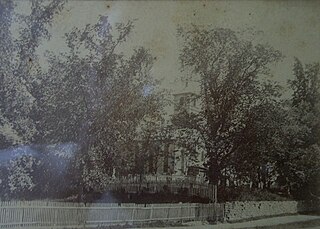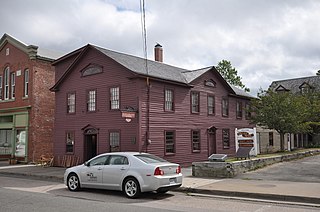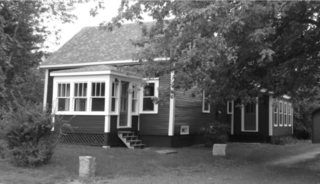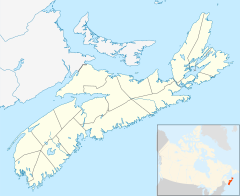
Nova Scotia is one of the thirteen provinces and territories of Canada. It is one of the three Maritime provinces and one of the four Atlantic provinces. Nova Scotia is Latin for "New Scotland".

Province House in Halifax is where the Nova Scotia legislative assembly, known officially as the Nova Scotia House of Assembly, has met every year since 1819, making it the longest serving legislative building in Canada. The building is Canada's oldest house of government. Standing three storeys tall, the structure is considered one of the finest examples of Palladian architecture in North America.

Annapolis Royal is a town in and the county seat of Annapolis County, Nova Scotia, Canada. The community, known as Port Royal before 1710, is recognised as having one of the longest histories in North America, preceding the settlements at Plymouth, Jamestown and Quebec. For nearly 150 years, it served as the capital of Acadia and subsequently Nova Scotia until the establishment of Halifax in 1749.

Fort Anne is a historic fort protecting the harbour of Annapolis Royal, Nova Scotia. It was built by Scottish settlers in August 1629 as Charles Fort. For the first 120 years of the fort's service period, the settlement of Port Royal, later Annapolis Royal, was the capital of the New France colony of Acadia and British North America colony of Nova Scotia. In 1917, Fort Anne became the first National Historic Site of Canada. Although no longer in active service, it is the oldest extant fort in Canada. Fort Anne has provided more defensive service than any other fort in North America, having been attacked and blockaded at least 19 times over a service period of 225 years, from the Acadian Civil War through to the American Revolutionary War. The fort also contains the oldest military building in Canada and the oldest building administered by Parks Canada, the 1708 powder magazine.

Government House of Nova Scotia is the official residence of the lieutenant governor of Nova Scotia, as well as that in Halifax of the Canadian monarch. It stands in the provincial capital at 1451 Barrington Street; unlike other provincial Government Houses in Canada, this gives Nova Scotia's royal residence a prominent urban setting, though it is still surrounded by gardens.

St. Paul's Church is an evangelical Anglican church in downtown Halifax, Nova Scotia, within the Diocese of Nova Scotia and Prince Edward Island of the Anglican Church of Canada. It is located at the south end of the Grand Parade, an open square in downtown Halifax with Halifax City Hall at the northern end.

The Old Burying Ground is a historic cemetery in Halifax, Nova Scotia, Canada. It is located at the intersection of Barrington Street and Spring Garden Road in Downtown Halifax.

John Ritchie was a Scottish-born merchant and politician in Nova Scotia. He represented Annapolis County in the Nova Scotia House of Assembly from 1783 to 1785.
Thomas Ritchie was a lawyer, judge and political figure in Nova Scotia. He represented Annapolis County in the Nova Scotia House of Assembly from 1806 to 1824.

Formally known as "His Majesty's Council of Nova Scotia", the Nova Scotia Council (1720–1838) was the original British administrative, legislative and judicial body in Nova Scotia. The Nova Scotia Council was also known as the Annapolis Council and the Halifax Council. After 1749, when the judicial courts were established, the Nova Scotia Council was limited to administrative and legislative powers.

The Old Parish Burying Ground is the oldest protestant cemetery in Windsor, Nova Scotia and one of the oldest in Canada. The graveyard was located adjacent to the first protestant church in Windsor (1788). The oldest marker of Rachel Kelley is dated 1771, twelve years after the New England Planters began to settle the area.

The Raid on Annapolis Royal took place on 29 August 1781 during the American Revolutionary War. The raid involved two American privateers - the Resolution and the Reprisal - attacking and pillaging Annapolis Royal, Nova Scotia in revenge of the defeat of the Penobscot Expedition. The privateers took captive the commander of the militia John Ritchie, described as the "Governor of Annapolis." One historian described it as "one of the most daring and dramatic raids upon Nova Scotia."

The Bailey House in Annapolis Royal, Nova Scotia, Canada is a historic house built around 1770, making it one of the oldest wood frame houses in Canada. It has been operating as a lodging, with interruptions, since at least 1837. The building is a Georgian style and is largely unaltered since its original construction. The house is part of the Annapolis Royal Historic District.
The de Gannes-Cosby House in the Annapolis Royal Historic District is the oldest wood framed building in Canada. It is also the world's oldest existing building in the Acadian style. It was built in 1708 by Major Louis-Joseph de Gannes de Falaise, a French nobleman and officer stationed at the French colony of Port Royal in what is today the province of Nova Scotia. The house is built on the foundations of an earlier house destroyed during the 1707 Siege of Port Royal. The core house was a simple wattle and daub construction, but has since been covered in wooden shingles and enlarged in the 19th and 20th centuries. It has been designated as a National Historic Site and is part of the Annapolis Royal Historic District.

The Sinclair Inn is an inn located in Annapolis Royal, Nova Scotia (Canada). Resulting from the amalgamation of two early eighteenth-century houses, it is the only Acadian building in the Annapolis Royal region to have survived from before the Great Upheaval (1750-1780). It was also the site of the first Masonic lodge in Canada in 1738. It was used as an inn between 1780 and 1950. It was then converted into a museum. The building was designated a National Historic Site of Canada in 1983. It was also listed as a municipal heritage property in 1982 and as a provincial heritage property in 1992.

North Hills Museum is a house-museum located in Granville Ferry, Nova Scotia, Canada. It is a neoclassical house built around 1764 and is one of the oldest wood framed buildings in Canada. It was bought in 1784 by the Ambermans, a Loyalist family from New York State, who owned the house for six generations. In 1964, it was purchased by Robert Patterson, an antique collector who restored the house to an 18th century appearance. Upon his death in 1974, he willed the house to the Province of Nova Scotia.

For the main article on the town, see Annapolis Royal
The O'Dell House Museum is a house-museum located in Annapolis Royal, Nova Scotia, Canada which presents a collection of artefacts important to the history of Annapolis Royal. The museum also houses the Annapolis Heritage Society's Genealogy Centre and its Archive and Collections Centre. The original building was constructed in 1869 by Nova Scotia Pony Express rider, Corey O’Dell. A Victorian house in Greek revival style, it is part of the Historic District of Annapolis Royal.

The Williams House is a historic house located in Annapolis Royal, Nova Scotia, Canada. Constructed in 1715, the building was located at 248 Saint George Street until 1875 when the main portion of the house was moved to 167 Saint Anthony Street. The ell of the house, dating from c. 1730, was moved to 62 Chapel Street. Although the location has moved, it remains one of the oldest wood-framed houses in Canada. The building is part of the Historic District of Annapolis Royal.















